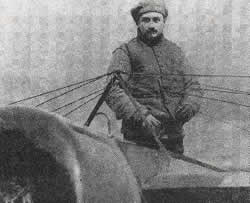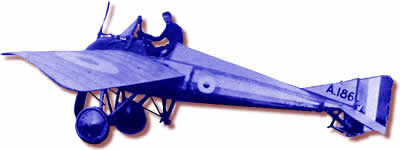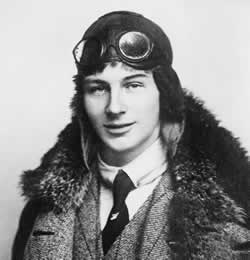 Famous French airman and invention captured
Famous French airman and invention captured
18 April 1915
On 18th April British pilots making air reconnaissance over the rear German areas reported a lot of activity and extra rolling stock on the railway at Wervicq. It appeared to be German troop reinforcements arriving in the area. In fact, it was quite the opposite; on the orders of General von Falkenhayn German troops were starting to leave the 4th Army's Ypres battlefront for the operation at Galicia on the Eastern Front.

|
On the same day the famous French pilot Lieutenant Roland Garros (1882-1918) was flying his single-seater plane, a Morane Saulnier Type L, on a bombing raid to Kortrijk railway station. Before the outbreak of war Roland Garros had been a test-pilot for the Morane-Saulnier company. He was an experienced aerobatics pilot. Before the war he had won the Paris-Madrid and Paris-Rome flying races twice. In 1911 he had won the west-European round-flight. In the same year he achieved the world record for the highest flight; 4,250 metres.
During his mission on 18th April, he flew low over a train near Ingelmunster in Flanders. He was fired on by a German Bahnschutzwache (Railway Protection Guard). A rifle bullet apparently hit his petrol pipe and he was forced to land. Although he tried to set the plane on fire and escape on foot, both he and his plane were captured by the Germans.
A German Account of the Incident

|
A report of the incident on 18th April was written by the leader of the Bahnschutzwache unit, Feldwebelleutnant Schlendstedt, and published in the Bulletin of the German 4th Army:
“At about 7 o'clock in the evening of 18 April two enemy aircraft, flying very high, appeared over the area between Sainte-Katherine and Lendelede. One was shot at by one of our Ballonabwehrkanone and he disappeared in the direction of Menin. The other flew away over Lendelede in a north-easterly direction. At that moment we saw a southbound train approaching on the railway line Ingelmunster-Kortrijk. Suddenly the plane went into a steep dive of about 60 degrees from a height of about 2,000 metres to about 40 metres from the ground. He flew over the train in a loop and as he rose up into the sky again with his wings almost vertical, he threw a bomb at the train. Fortunately it missed the target and there was no damage. The bomb landed about 40 metres east of the track and blew a crater about one metre deep and two metres in diameter. The driver of the locomotive brought the train to a stop.
As the plane had swooped down over the train the Bahnschutzwache troops had fired on it following my order to open fire. We shot at him from a distance of only 100 metres as he flew past. After he had thrown his bomb at the train he tried to escape, switching his engine on again and climbing to about 700 metres through the shots fired by our troops. But suddenly the plane began to sway about in the sky, the engine fell silent, and the pilot began to glide the plane down in the direction of Hulste.
I immediately got on on my bicycle and set off to chase the plane, accompanied by some of the men from my unit on foot. As soon as the plane landed the pilot set it on fire and ran to a farmhouse in Hulst. I was the first to arrive at the scene of the burning plane. Several others soon joined me and my men, including some dragoons from a Württemberger cavalry brigade, as we searched for the airman in Hulste.” (1)
Disputed Claims for the Capture of Garros
The honour for the capture of this pilot became a matter of dispute between the Saxon Landsturm Feldwebelleutnant Schlenstedt and the Württemberger cavalrymen mentioned in his account. One version of the story was published in the “Schwabishen Merkur” newspaper by a Württemberger cavalry medical officer:
“As I rode along the ditches with two other dragoons, one of them suddenly shouted, ‘There he is!’ I turned my horse around and made my way back to him and saw that he had already drawn his sword. When the pilot he had found saw me and the third dragoon approach with a rifle he stood up quickly. Seeing the pilot put his hands into his pockets I shouted: ‘Levez les bras!’ and ‘Hands up!’ several times, which he did. But when we examined his pockets we only found some coins and a few pieces of paper.
With one of us on either side of him we took him by the wrists and led him off. He was a good-looking, dark-haired Frenchman with a high white forehead, a slightly crooked nose and a small black beard. With his lips pressed together he looked at us in wide-eyed amazement. Nevertheless, he remained calm. He was covered with mud on his right side; he had buried himself in the ditch and had covered himself with clumps of grass to hide from us. The dragoon who had spotted him had seen the grass move in the ditch and had seen a piece of blue uniform.
The pilot was wearing a blue fabric jacket with a small stiff collar, which had two brass wings on it. On his breast he wore a red medal ribbon. He was bare-headed and his black hair stuck to his forehead with a mixture of sweat and blood. We couldn't see an obvious wound on him. He had probably scratched himself as he scrambled through the thorn hedge which was growing through the fence where we caught him.
The dragoon who had spotted the pilot was singled out for praise by the General commanding the division; the dragoon was told that he had captured France's best and most daring pilot officer, namely Roland Garros.” (2)
The Germans Unwittingly Capture a French Invention
The importance of the shooting down of Lieutenant Roland Garros was that his plane was fitted with a recently developed device to enable bullets from a Hotchkiss machine-gun to fire through the blades of the propellor in a front-engined aeroplane.
The concept of being able to fire bullets through the blades of a turning propellor had been studied from 1912 and although some devices had been patented, none had been without problems. Once war broke out Roland Garros had joined up as a pilot in the French air service, L'Aviation Militaire. Taking leave from his squadron at the end of 1914 he went back to the Morane-Saulnier factory as a test-pilot to try out the latest innovations for firing machine-guns through the blades of a propellor by Raymond Saulnier. Garros had returned to his fighting unit in March 1915 and between 1st and 18th April he shot down five German aircraft using the latest deflector device on his Morane aeroplane (3).

|
Within a few hours of his forced landing on 18th April by the German 4th Army, as described above, the machine-gun firing device and the Morane's propellor were sent to the Fokker aircraft factory in Germany. It was a mere few weeks later that the Dutchman Anthony Fokker produced the first single-seater aeroplane - the Fokker EI - for the German Air Force fitted with machine-guns, deflectors and an interruptor gear which could synchronise the rate of fire of the gun with the speed of the propellor. The first Fokker EIs to be put into production in small numbers arrived on the Western Front from mid 1915. The Fokker E-types served on the Western Front from mid 1915 to mid 1916 and in that time the 300 or so Fokker E-types of the German Air Force were responsible for shooting down over 1,000 Allied aircraft. (4)
The capture of Garros' plane on 18th April had, without doubt, created a fortuitous opportunity for the German Air Force to examine and develop further an invention which was to become crucial in the fight for supremacy of the skies. (5)
Garros did escape from his imprisonment by the Germans and rejoined the French Aviation Militaire. He was killed in action in October 1918.
Next>> Second attempt to launch the attack
Acknowledgements
(1) Der Völkerkrieg, V. Band, p. 188
(2) Der Völkerkrieg, V. Band, p. 189
(3) An Illustrated Companion to the First World War, p. 150
(4) An Illustrated Companion to the First World War, p. 131
(5) The First Great Air War, Richard Townsend Bickers, p. 77-78
Photograph of Roland Garros courtesy of Wikimedia Commons.
Photograph of Anthony Fokker courtesy of Wikimedia Commons.